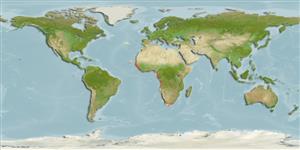>
Anguilliformes (Eels and morays) >
Ophichthidae (Snake eels) > Ophichthinae
Etymology: Mystriophis: Greek, mystrion = spoon + Greek, ophis = serpent.
Eponymy: Dr Alain Georges Paul Crosnier (1930-2021) was a French biologist and carcinologist at the MNHN, Paris, who published much on crustaceans. He initiated the deep trawling surveys off Madagascar (1970s). (Ref. 128868), visit book page.
Environment: milieu / climate zone / depth range / distribution range
Ökologie
seewasser demersal; tiefenbereich 75 - 300 m (Ref. 4455). Tropical
Eastern Atlantic: Senegal to Angola including western Mediterranean.
Size / Gewicht / Alter
Maturity: Lm ? range ? - ? cm
Max length : 96.5 cm TL Männchen/unbestimmt; (Ref. 4455)
Burrows in sand or mud near the edge of the continental shelf (Ref. 4455).
Life cycle and mating behavior
Geschlechtsreife | Fortpflanzung | Ablaichen | Eier | Fecundity | Larven
Leiby, M., 1990. Ophichthidae. p. 176-192. In J.C. Quero, J.C. Hureau, C. Karrer, A. Post and L. Saldanha (eds.) Check-list of the fishes of the eastern tropical Atlantic (CLOFETA). JNICT, Lisbon; SEI, Paris; and UNESCO, Paris. Vol. 1. (Ref. 4455)
IUCN Rote Liste Status (Ref. 130435: Version 2024-2)
Bedrohung für Menschen
Harmless
Nutzung durch Menschen
Tools
Zusatzinformationen
Download XML
Internet Quellen
Estimates based on models
Preferred temperature (Ref.
123201): 13.4 - 17.7, mean 15.3 °C (based on 28 cells).
Phylogenetic diversity index (Ref.
82804): PD
50 = 0.7500 [Uniqueness, from 0.5 = low to 2.0 = high].
Bayesian length-weight: a=0.00091 (0.00039 - 0.00215), b=2.99 (2.79 - 3.19), in cm total length, based on LWR estimates for this (Sub)family-body shape (Ref.
93245).
Trophic level (Ref.
69278): 3.5 ±0.50 se; based on food items.
Widerstandsfähigkeit (Ref.
120179): mittel, Verdopplung der Population dauert 1,4 - 4,4 Jahre. (Preliminary K or Fecundity.).
Fishing Vulnerability (Ref.
59153): High vulnerability (59 of 100).
Nutrients (Ref.
124155): Calcium = 84 [51, 155] mg/100g; Iron = 0.932 [0.552, 1.473] mg/100g; Protein = 17.9 [15.7, 20.4] %; Omega3 = 0.199 [0.087, 0.542] g/100g; Selenium = 108 [57, 209] μg/100g; VitaminA = 11.3 [3.6, 33.1] μg/100g; Zinc = 0.864 [0.635, 1.224] mg/100g (wet weight);
